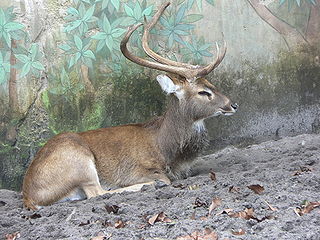The Manipuri Brow-antlered Deer or ‘sangai‘ or ‘dancing deer’, a critically endangered species of deer, which lives in a unique floating habitat is facing a threat of extinction as the floating biomass (or ‘phumdis’) on which it walks has been steadily decreasing in buoyancy and thickness over the last few years. As a result, Sangai face death from drowning as the phumdis may not be able to support its weight. This has also restricted the mobility of the species, leading to inbreeding. The sangai’s habitat is 9 sq kms of the 40 sq kms in the Keibul Lamjao National Park (KMLP). Multiple threats stalk the sangai. The primary reason for the phumdis decrease is the Loktak hydro electric project. It has been keeping the water level in the lake artificially high, which separates the phumdis from the ground, preventing their absorption. Pollution and poaching are also a problem, as is the spread of the invasive para grass.
The Sangai is an endemic, rare and endangered Brow-antlered deer found only in Manipur, India. Its common English name is Manipur Brow-antlered Deer and the scientific name, Rucervus eldi eldi. It lives in the marshy wetland in Keibul Lamjao about 45 km from Imphal. Its habitat is located in the southern parts of the Loktak Lake, which is the largest freshwater lake in Eastern India. It is also one of the seven Ramsar sites of international importance. Sangai is also the state animal of Manipur.


 CI is a non-profit, non-commercial portal that aims to facilitate wildlife and nature conservation by providing reliable information and the tools needed to campaign effectively.
CI is a non-profit, non-commercial portal that aims to facilitate wildlife and nature conservation by providing reliable information and the tools needed to campaign effectively.